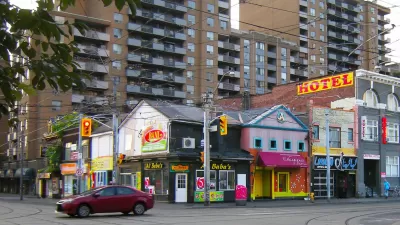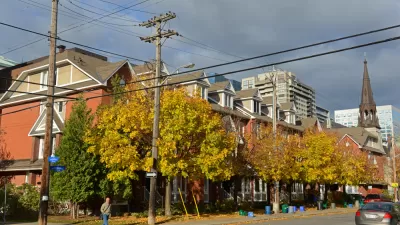In the fifty years since Jane Jacobs introduced the "eyes on the street" theory, it's become a commonly accepted conceit that a mix of use reduces crime. A new study calls that theory into question.
"Jane Jacobs 'had it backwards,' according to a report in this month’s University of Pennsylvania Law Review."
Matt Bevilacqua discusses the findings reported by researchers from RAND, the University of Pennsylvania, and the University of Southern California.
"Focusing on more than 200 blocks in eight high-crime Los Angeles neighborhoods, the report found that areas zoned for mixed-use development had lower crime rates than those zoned for commercial uses only. Areas purely made up of residences, however, had lower crime rates than either."
“[W]e find that residential zoning is associated with substantially lower crime than commercial zoning or mixed-use zoning,” the researchers write, later adding, “With respect to natural surveillance, we find no support for Jacobs’s argument that commercial uses will reduce crime by encouraging a robust street life and ‘eyes on the street.’”
"The report also notes that assaults, robberies, thefts and burglaries decreased when residential housing was introduced into single-use commercial zones," adds Bevilacqua. "These crimes increased, however, when businesses were introduced into residiential-only [sic] areas, backing up the notion, for one, that a 'place of business in a residence neighborhood furnishes an excuse for any criminal to go into the neighborhood.'”
"The authors do stress the need for further research on the built environment before drawing any definitive conclusions about its effect on crime rates," he concludes. "So it will take more evidence before we can heed the suggestion that new urbanists have been mixing it up all these years."
FULL STORY: Researchers Challenge Jane Jacobsian Notion that “Eyes On the Street” Reduce Crime

Planetizen Federal Action Tracker
A weekly monitor of how Trump’s orders and actions are impacting planners and planning in America.

Map: Where Senate Republicans Want to Sell Your Public Lands
For public land advocates, the Senate Republicans’ proposal to sell millions of acres of public land in the West is “the biggest fight of their careers.”

Restaurant Patios Were a Pandemic Win — Why Were They so Hard to Keep?
Social distancing requirements and changes in travel patterns prompted cities to pilot new uses for street and sidewalk space. Then it got complicated.

Platform Pilsner: Vancouver Transit Agency Releases... a Beer?
TransLink will receive a portion of every sale of the four-pack.

Toronto Weighs Cheaper Transit, Parking Hikes for Major Events
Special event rates would take effect during large festivals, sports games and concerts to ‘discourage driving, manage congestion and free up space for transit.”

Berlin to Consider Car-Free Zone Larger Than Manhattan
The area bound by the 22-mile Ringbahn would still allow 12 uses of a private automobile per year per person, and several other exemptions.
Urban Design for Planners 1: Software Tools
This six-course series explores essential urban design concepts using open source software and equips planners with the tools they need to participate fully in the urban design process.
Planning for Universal Design
Learn the tools for implementing Universal Design in planning regulations.
Heyer Gruel & Associates PA
JM Goldson LLC
Custer County Colorado
City of Camden Redevelopment Agency
City of Astoria
Transportation Research & Education Center (TREC) at Portland State University
Camden Redevelopment Agency
City of Claremont
Municipality of Princeton (NJ)





























